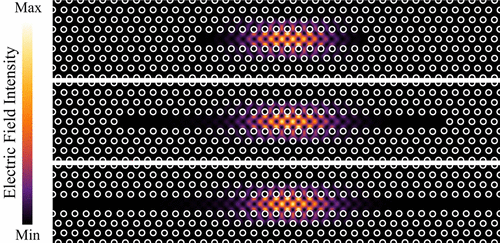当前位置:
X-MOL 学术
›
ACS Photonics
›
论文详情
Our official English website, www.x-mol.net, welcomes your feedback! (Note: you will need to create a separate account there.)
Anderson Localization in Disordered LN Photonic Crystal Slab Cavities
ACS Photonics ( IF 7 ) Pub Date : 2018-01-15 00:00:00 , DOI: 10.1021/acsphotonics.7b00967 Juan Pablo Vasco 1 , Stephen Hughes 1
ACS Photonics ( IF 7 ) Pub Date : 2018-01-15 00:00:00 , DOI: 10.1021/acsphotonics.7b00967 Juan Pablo Vasco 1 , Stephen Hughes 1
Affiliation

|
We present a detailed theoretical study of the effects of structural disorder on LN photonic crystal slab cavities, ranging from short to long length scales (N = 3–35 cavity lengths), using a fully three-dimensional Bloch mode expansion technique. We compute the optical density of states (DOS), quality factors and effective mode volumes of the cavity modes, with and without lattice disorder, and compare with the localized modes of the corresponding disordered photonic crystal waveguide. We demonstrate how the quality factors and effective mode volumes saturate at a specific cavity length, and become bounded by the corresponding values of the Anderson modes appearing in the disordered waveguide. By means of the intensity fluctuation criterion, we find Anderson-like localization for cavity lengths larger than around L31, and show that the field confinement in the disordered LN cavities is mainly determined by the local characteristics of the structural disorder as long as the confinement region is far enough away from the cavity mirrors and the effective mode localization length is much smaller than the cavity length; under this regime, the disordered cavity system becomes insensitive to changes in the cavity boundaries, and a good agreement with the intensity fluctuation criterion is found for Anderson localization. Surprisingly, we find that the Anderson-like localized modes do not appear as new disorder-induced resonances in the main spectral region of the LN cavity modes, and moreover, the disordered DOS enhancement is largest for the disordered waveguide system with the same length. These results are fundamentally interesting for applications such as lasing and cavity-QED, and provide new insights into the role of the boundary condition (e.g., open vs mirrors) on finite-size slow-light waveguides. They also point out the limits of using models based on the cavity boundaries/mirrors and a single slow-light Bloch mode to describe cavity systems with large N.
中文翻译:

LN光子晶体平板腔中的安德森局部化
我们提出了对LN光子晶体平板腔的结构紊乱影响的详细理论研究,范围从短到长(N= 3–35腔长度),使用完全三维Bloch模式扩展技术。我们计算了有无晶格无序的状态的光密度(DOS),质量因数和腔模的有效模量,并与相应的无序光子晶体波导的局域模进行了比较。我们证明了品质因数和有效模量如何在特定的腔长处饱和,并受到出现在无序波导中的安德森模的相应值的限制。利用强度涨落准则,我们发现腔长大于L 31的安德森式定位,并证明了无序LN中的场约束空腔主要由结构紊乱的局部特征决定,只要限制区域离空腔镜足够远并且有效模式定位长度远小于空腔长度即可。在这种情况下,无序的腔体系统对腔体边界的变化变得不敏感,并且与强度波动准则在安德森定位中有很好的一致性。出乎意料的是,我们发现在LN的主要光谱区域中,像Anderson一样的局域模并不像新的由疾病引起的共振一样出现腔模式,此外,对于具有相同长度的无序波导系统,无序DOS增强最大。这些结果对于诸如激光和腔QED之类的应用从根本上来说是有趣的,并为边界条件(例如,开放与反射镜)在有限尺寸的慢光波导上的作用提供了新的见解。他们还指出了使用基于腔边界/镜和单个慢光Bloch模式描述具有大N的腔系统的模型的局限性。
更新日期:2018-01-15
中文翻译:

LN光子晶体平板腔中的安德森局部化
我们提出了对LN光子晶体平板腔的结构紊乱影响的详细理论研究,范围从短到长(N= 3–35腔长度),使用完全三维Bloch模式扩展技术。我们计算了有无晶格无序的状态的光密度(DOS),质量因数和腔模的有效模量,并与相应的无序光子晶体波导的局域模进行了比较。我们证明了品质因数和有效模量如何在特定的腔长处饱和,并受到出现在无序波导中的安德森模的相应值的限制。利用强度涨落准则,我们发现腔长大于L 31的安德森式定位,并证明了无序LN中的场约束空腔主要由结构紊乱的局部特征决定,只要限制区域离空腔镜足够远并且有效模式定位长度远小于空腔长度即可。在这种情况下,无序的腔体系统对腔体边界的变化变得不敏感,并且与强度波动准则在安德森定位中有很好的一致性。出乎意料的是,我们发现在LN的主要光谱区域中,像Anderson一样的局域模并不像新的由疾病引起的共振一样出现腔模式,此外,对于具有相同长度的无序波导系统,无序DOS增强最大。这些结果对于诸如激光和腔QED之类的应用从根本上来说是有趣的,并为边界条件(例如,开放与反射镜)在有限尺寸的慢光波导上的作用提供了新的见解。他们还指出了使用基于腔边界/镜和单个慢光Bloch模式描述具有大N的腔系统的模型的局限性。



























 京公网安备 11010802027423号
京公网安备 11010802027423号